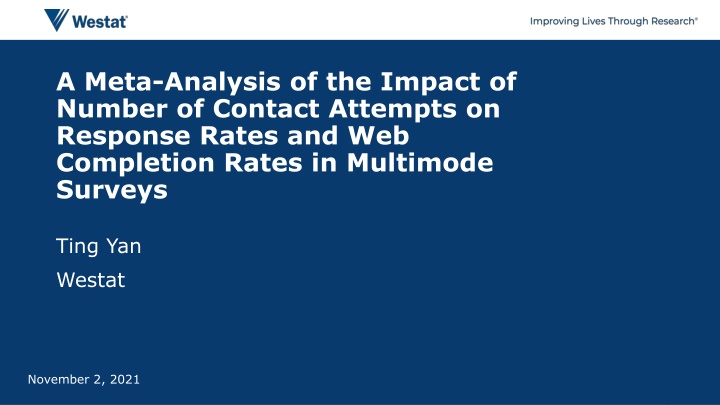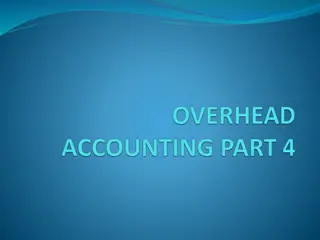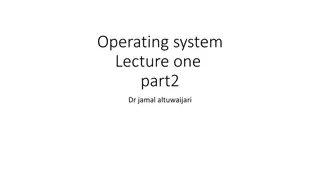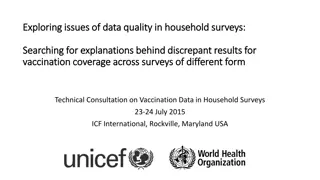Impact of Number of Contact Attempts on Response Rates in Multimode Surveys
This meta-analysis investigates the effects of the number of contact attempts on response rates and web completion rates in multimode surveys. Benefits of multimode surveys include improving coverage, increasing response rates, reducing costs, and enhancing measurement accuracy by utilizing multiple modes of contact. The study focuses on utilizing mail and web methods to gather data from survey respondents and explores the impact of design features on response rates, web completion rates, and overall survey costs.
Download Presentation

Please find below an Image/Link to download the presentation.
The content on the website is provided AS IS for your information and personal use only. It may not be sold, licensed, or shared on other websites without obtaining consent from the author.If you encounter any issues during the download, it is possible that the publisher has removed the file from their server.
You are allowed to download the files provided on this website for personal or commercial use, subject to the condition that they are used lawfully. All files are the property of their respective owners.
The content on the website is provided AS IS for your information and personal use only. It may not be sold, licensed, or shared on other websites without obtaining consent from the author.
E N D
Presentation Transcript
A Meta-Analysis of the Impact of Number of Contact Attempts on Response Rates and Web Completion Rates in Multimode Surveys Ting Yan Westat November 2, 2021
Multimode surveys Multimode surveys are on the rise Using multiple modes to contact and to collect data from potential respondents Benefits (de Leeuw 2018; Tourangeau 2017): Improving coverage Increasing response rates Reducing cost Improving measurement COVID-19 2
This talk Focuses on multimode surveys using mail and web to collect data from potential respondents Using a meta-analytic approach to quantifying two benefits (de Leeuw 2018; Tourangeau 2017): Improving coverage Increasing response rates Impact of design features on response rate Reducing cost Impact of design features on percent of web completes Improving measurement 3
Types of web and mail multimode designs Concurrent Web and mail are offered to respondents at the same time HINTS 5 Web Pilot (Westat, 2019): Web option condition 1st contact: web login + paper questionnaire 2nd contact: Postcard reminder 3rd contact: letter reminder with web login + paper questionnaire 4th contact: letter reminder with web login + paper questionnaire 4
Types of web and mail multimode designs Sequential mail and web Paper questionnaire is offered first and web is offered later Lewiston and Clarkston Quality of Life Survey (Smyth et al. 2010) 1st contact: pre-notification letter 2nd contact: paper questionnaire 3rd contact: postcard reminder 4th contact: paper questionnaire + web login 5
Types of web and mail multimode designs Sequential web and mail Web is offered first and paper questionnaire offered later 2015 VA Survey of Veteran Enrollee s Health and Use of Health Care (Westat, 2015): Hard-to-interview control condition 1st contact: pre-notification letter 2nd contact: invitation letter with web login 3rd contact: IVR reminder 4th contact: letter reminder with paper questionnaire 5th contact: Postcard reminder 6th contact: letter reminder with paper questionnaire 6
Impact of design features of multimode surveys Type of design Number of contacts Was a pre-notification letter sent? Was incentive offered? Was email used to reach sampled persons? Timing of the second mode 7
Meta-analysis Searched for experimental studies that varied design features Key words: multimode, mixed mode, multiple modes of data collection, web, mail, paper, sequential, concurrent, choice, push-to- web Reviewed studies for eligibility Has to be empirical studies Has to include experiments Has to include sufficient information on design features, sample size, response rate, number of web completes or percent of web completes Retained 29 papers for coding 38 studies 113 estimates 8
Meta-analysis (2) For each eligible study, Coded design features (e.g., type of multimode design etc) Entered or manually calculated Response rate Percent of interviews completed on web Calculated effect size (and variance) Logit transformation of response rate and web completion rate ?? ???= log? 1 (1 ??) ??= (?? ?? 1 ??) ??= 1?? 9
Meta-analysis (3) Average effect size by type of multimode designs ?? = ? Moderator analysis ? ?=1 ????? ??? design features 10
Results: Response rates by type of multimode designs Concurrent mail/web designs: 28 effect sizes nested in 17 studies nested in 14 papers Sequential mail/web: 15 effect sizes nested in 11 studies nested in 10 papers Sequential web/mail: 70 effect sizes nested in 34 studies nested in 26 papers 11
Results: Response rates by number of contacts Ranging from 2 to 17 Mode number of contacts Concurrent: 5 Mail/web: 4 Web/Mail: 4 Overall effect 0.12 (p<.0001) 12
Results: Response rates by pre-notification letter % sent a pre-notification letter: Concurrent: 61% Mail/web: 73% Web/Mail: 57% Overall effect 0.29 (p<.05) 13
Results: Response rates by incentive % offered incentive Concurrent: 64% Mail/web: 73% Web/Mail: 44% Overall effect 0.41 (p=.002) 14
Results: Response rates by use of email Email use Concurrent: 1 study used email reminder Mail/web: 1 study sent web survey via email Web/Mail: 7%: email invitation 14%: email reminder 11%: both 66%: did not use email 15
Results: Response rates by timing of second mode Most studies offered 2nd mode 2 contacts after 1st mode 16
Summary of findings on Response Rate Design Feature Impact on Response Rate Type of design mail/web > (concurrent = web/mail) Number of contacts Pre-notification Incentive concurrent and web/mail: mail/web: Email reminder: Email (web/mail only) Timing of 2nd mode mail/web: higher RR when offering 2nd mode 1 or 2 contacts later web/mail: higher RR when offering 2nd mode 2 or 3 contacts later 17
Results: Web completion rates by use of email (Sequential web/mail only) 22
Summary of findings on web completion rate Design Feature Impact on web completion rate Type of design web/mail > concurrent > mail/web Number of contacts concurrent and web/mail: Pre-notification concurrent and mail/web: web/mail: concurrent and web/mail: Incentive mail/web: Email invitation+ email reminder: Email (web/mail only) Timing of 2nd mode mail/web: higher WCR when offering 2nd mode 1 contact later web/mail: higher WCR when offering 2nd mode 2 or 4+ contacts later 24
Recommended sequence If goal is to maximize response rate Concurrent: 6 contacts, pre-notification, incentive, Mail/web: 4 contacts, pre-notification, no incentive, offering web at 3rd contact Web/mail:7+ contacts, pre-notification, incentive, offering mail at 4th contact, email reminder If goal is maximize web completion rate Concurrent: 6 contacts, no pre-notification, incentive Mail/web: 3 contacts, no pre-notification, no incentive, offering web at 2nd contact Web/mail: 6 contacts, pre-notification, incentive, offering mail at 6th contact, email invitation+email reminder 25
Limitations and Future Research Only examined a few selected moderators Future research should examine other moderators such as target population, type of sampling frame, type and amount of incentives, survey topic Only examined one moderator at a time Future research could employ a meta-regression approach to examine the impact of all moderators at the same time Limited to studies involving an experiment Future research could expand to include empirical studies that do not include an experiment 26
Thank You tingyan@Westat.com *A big thank-you to Alexis Kokoska and Winnie Xu for their help with coding 27























